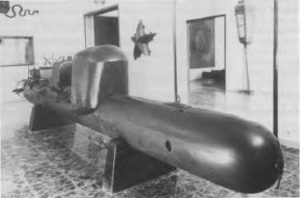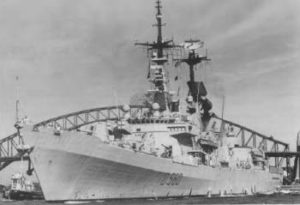- Author
- Morgan, Admiral, RN
- Subjects
- Ship histories and stories, WWII operations
- Tags
-
- RAN Ships
- None noted.
- Publication
- June 1997 edition of the Naval Historical Review (all rights reserved)
Few people who saw the Italian Guided Missile Destroyer LUIGI DURAND DE LA PENNE during her visit to Sydney will know of this story of the person for whom she was named.
Some years ago when in Venice, I visited the Museo Storico Navale Venezia. In the entrance hall stood a replica of an Italian 2 man torpedo of the kind which was used to sink two RN battleships in Alexandria Harbour on 19 December, 1941. It was thought that 3 of these vessels came through the boom at 0100 in the wake of destroyers (including HMAS Nizam) returning from the Battle of Sirte Gulf. On the wall of the museum was a letter written in 1946 by Admiral Morgan, R.N. who, as a Captain, was in command of “Valiant” at the time of her sinking. I will let this letter tell the story of the exploit and of its quite incredible sequel. W.F.C.
Admiralty London SW
Decoration of Lieut. de la Penne with the Italian Gold Medal for Valour

On the 19th December, 1941, the British Fleet in Alexandria Harbour was attacked by 3 Italian 2 man torpedoes. The Senior Officer of the flotilla Lieut. de la Penne, Royal Italian Navy, with his Artificer Diver attacked HMS “Valiant” of which I was then Commanding Officer. They were captured swimming in the water alongside the ship at about 3 am and for the next 3 hours de la Penne was my prisoner onboard the ship. As he refused to say whether he had attached anything to the ship, I placed him down below close to that part of the ship’s side where I thought the explosive charge might have been fixed.
At about 05.45 I was told that Lieut. de la Penne wished to speak to me and I had him brought up to the Wardroom. All he would say was that very soon there would be some explosion but he still refused to say whether or not any charge had been attached to the ship. I therefore had him taken down below again, closed all WIT doors, cleared lower deck and ordered all officers and men onto the upper deck.
At 06.04 an explosion occurred under the ship which blew a very large hole in the hull abreast “B” turret, twenty one feet below the waterline. There were no casualties, but as a result of the damage the ship was out of action for over 5 months. Neither Lieut. de la Penne nor his assistant were injured by the explosion as they were in a compartment well forward of the damage. Later on I learnt from de la Penne that the charge was not slung under the ship, as he had intended, but owing to a mishap had to be placed on the bottom of the harbour below the ship, and he was uncertain what effect the explosion would have on the ship with the bomb in this position. Lieut. Penne was taken ashore about 06.30 and I did not meet him again until he was repatriated from India in 1944 when I was Admiral Commanding Taranto and the Adriatic. After this he came to see me quite frequently, and not only gave me his version of the attack on HMS “Valiant” but explained many other matters of which I had been in doubt. He was also most helpful in keeping me supplied with valuable information on the attitude and reactions of Italian Naval Officers especially the younger ones at that time. He subsequently played a most gallant part in the attack on Spezia and I did my utmost to obtain a British decoration for him. However, as we were officially still at war with the Italian nation, no awards were being granted to Italian naval officers.

Pictures: ABPH Simon Metcalfe
In March 1945, the Crown Prince of Italy came down to Sorrento to inspect the Italian ships and establishments. I lunched with him on the second day and accompanied him during his inspections which included a visit to St. Vito barracks where a presentation of medals was to take place. The first officer to be decorated with the Italian Gold Medal for Valour (equivalent to our VC) was Lieut. de la Penne for this attack on HMS “Valiant” on 19 December, 1941. After the citation had been read out to the parade, de la Penne came forward to the platform. As he did so, the Crown Prince turned round and said:
“Come on Morgan, this is your show“.
I stepped forward took the medal from the Crown Prince’s hand and pinned it on Lieut. de la Penne’s breast.
I thus had the pleasure, and honour of decorating Lieut. de la Penne with the highest award granted by the Italian Navy for the very courageous and gallant attack he made on my ship 3 years and 3 months before.
18 Oct. 1946




